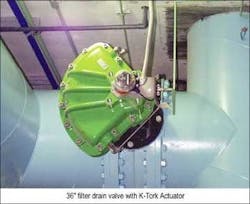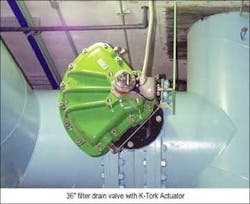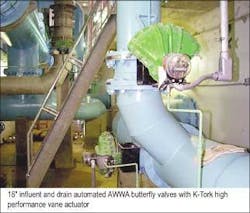New Option in Valve Actuators Aids Filter System Control
Rotary-action, pneumatic technology provides a simple, accurate and reliable alternative to controlling valves in filter operations, answering the need for water works engineers to better control turbidity levels while reducing downtime and premature backwashes.
Under pressure from the mandates of the Safe Drinking Water Act, water works engineers and plant managers are now forced to scrutinize all elements of their potable water treatment operations, and none is more important than filtering. Water leaving this point must fall within mandated turbidity levels. Over the past decade, much attention has been directed at plant control systems to achieve these levels. Like putting a dashboard from a new Cadillac onto a Model T, harnessing these modern systems to antiquated valve actuators yields little gain if precise valve control cannot be reproduced reliably.
In recognition of this, water works engineers are now turning to a new generation of pneumatic valve actuators that are up to the task of executing the instructions of electronic control systems with the necessary precision to accurately control effluent flow. The actuators feature a simple but rugged construction that helps reduce downtime. Also, a "fail safe"' (fail-closed or fail-open) feature that some high-performance pneumatic actuators provide protects the plant during a temporary or extended power outage.
Because valve control accuracy and reliability play such an important role in filtering operations, many older plants are currently upgrading and improving their systems. In most instances, the original pipe galleries and valves will remain in place. However, a new control system is usually the first step to be implemented. This changeover requires new actuators that interface with modern control systems.
Although electric actuators have been used for a number of years in automated control applications, newer pneumatic rotary actuator are also being designed for use with automated systems. An example are the rotary actuators manufactured by K-Tork, based in Dallas, TX. The company's actuators meet American Water Works Association standards and are an option for new facilities as well as plant upgrades.
The K-Tork actuator has been successful in filter applications in part because of it's simple design, which uses only one moving part. By scribing an arc, all torque forces directed to the valve remain constant from fully open to fully closed. Absent the need to convert linear motion to rotary, "pinch points" are avoided. Given a smaller torque-to-size ratio, compact vane actuators can fit into the tight quarters of filter galleries and still exert a tremendous amount of force on 1/4-turn valves, for instance.
The vane design also ensures accurate control and no hysteresis. Because no O-ring seals are needed, vane actuators can provide years of service in high-cycle, fast-operation and critical modulating applications.
K-Tork actuators even feature a "default" setting to protect treated water in the event that a power grid goes out. The actuator can be set to a plant operator's specification as to whether the valve should be held in the open or closed position. The rotary vane of the actuator then automatically holds that position until power is restored. This prevents the flooding of filter galleries.
Much appreciated by maintenance staff, the simple structure of pneumatic rotary-vane actuators allows "in-the-field" repair if necessary.
"In a smaller water treatment facility, say in a town of about 10,000, the city engineer and his staff may wear several different hats," said Rand Underwood, sales manager for K-Tork. "One day they might be doing road repairs, and the next day working in the water plant. But a pneumatic actuator with one moving part is simple to work on. If the guy can use a screwdriver or a wrench, he can pretty much understand how to fix a K-Tork vane actuator."
Given the advantages inherent with rotary actuators — coupled with the fact that they are generally less expensive than electric actuators — facility engineers are installing them in water works plants with growing frequency.
Some vane actuator designs come ready equipped for mounting into existing plants, while others don't.
"One problem is that the manufacturers of valves don't necessarily make the mounting hardware for retrofit," Underwood said. "That leaves a facility engineer or a supplier with the responsibility of sketching something out on a piece of paper and taking it to a local machine shop. 'I need some plates with some holes drilled in this pattern.' That's generally the way it occurs."
For challenging retrofits, some rotary-actuator manufacturers, send their experts out into the field to help facilitate the installation process. Factory personnel or a qualified representative does the survey on the valve and returns to the factory with the dimensions and recommended actuator sizing.
K-Tork offers seven sizes of actuators, with torque outputs up to 150,000 inch/pound and adjustable rotations from 80 to 100 degrees. Integral limit switches and positioners are installed. The mounting plate is then fabricated, set-up and tested with the actuator. This process also includes the correct control module to interface with the plant's existing PLC, SCADA or even older pneumatic systems. The actuator is then shipped to the plant with the correct valve mounting kit.
Such turnkey installation procedures make it easy for plant managers on a tight budget to initiate plant upgrades from maintenance money.
Conclusion
Given the lowered costs, operational advantages, and ease-of-installation afforded by pneumatic vane actuators, water treatment managers are awakening to this new option for optimizing their water production, avoiding downtime due to maintenance problems and remaining within federally mandated turbidity levels.
"Regulating agencies get very picky about when you take filters out of action," Underwood said. "They don't want a community or municipality to be without water. Plant operators just can't shut their plants down whenever they want to. So aside from the fact that the accurate control made possible by rotary actuation helps lower turbidity levels, it is their reliability and low cost of ownership that really matters to most plant managers."


